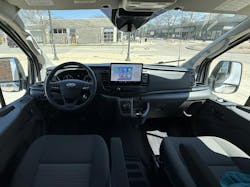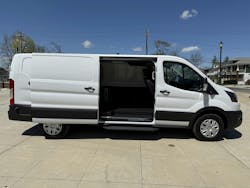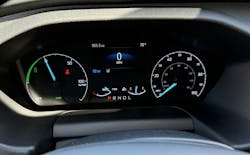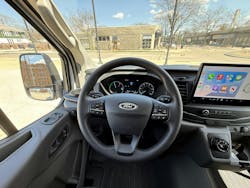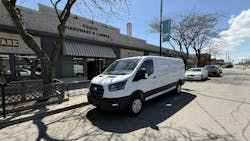Key takeaways:
- Ford is now in its second generation of the E-Transit, which first launched in 2022.
- After listening to customer feedback on the first generation, Ford’s new E-Transit offers faster charge time and an enhanced range of up to 32%.
- Ford designed the electric cargo van to be much like an ICE vehicle, which has its pros and cons.
It wasn’t long ago that Ford launched its all-electric cargo van, the E-Transit. Early iterations of the vehicle have been on the road since 2022. Now, the vehicle manufacturer has already launched its second-generation E-Transit with enhancements and upgrades that make the vehicle even more suited for commercial applications.
I had a chance to drive it around for a week. Here’s what you need to know:
E-Transit specs
2025 Ford E-Transit highlights:
- 159-mile range with faster charge time than the previous generation
- 266 hp and 317 lb.-ft. of torque
- 3,249-lb. maximum payload capacity with low roof and a long body type
- Three different models with six total vehicle configurations
- Assembled in the USA
Additional light-duty EV content:
- A side-by-side comparison of two fleets’ electrification journey
- The next-generation Ford E-Transit gets practical upgrades
- Driving an electric cargo van vs. ICE cargo van
The 2025 Ford E-Transit's electric motor offers 266 hp/198 kW of power and 317 lb.-ft. of torque. It’s also available with Ford’s Pro Power Onboard, which offers 2.4kW of on-board power for laptops and tools at the worksite.
Fleets have steadily adopted the Ford E-Transit since 2022. This has given Ford time to iron out all the wrinkles in its electric commercial product—an advantage for Ford customers seeking to go electric. It’s also given the manufacturer time to add product enhancements as technology has developed. An example of this is the E-Transit's range.
This enhanced range on the second-generation product brings the max range from 126 miles to 159 miles—which is an increase of “26% on low-roof and a 32% increase on high-roof models of the previous generation” of the E-Transit, FleetOwner reported last year when Ford made the announcement.
But that’s not the only enhancement to the new E-Transit.
See also: Ford Pro offers EV suitability insights, charging incentive and announces mobile service growth
EV technology
Another aspect of the Ford E-Transit that was developed over time and with customer input is the vehicle’s improved charging time, now available thanks to dual onboard chargers. Using a 180-kW or higher DC charger, the E-Transit can charge from 10% to 80% in just 28 minutes—perfect for a lunch break top-off. Using a lower-powered DC charger, the EV can charge from 10% to 80% in 82 minutes. But the new E-Transit also charges faster than the previous generation when using AC power. It takes 6 hours and 11 minutes for the EV to charge from 0 to 100% using an 80-amp home charger.
In addition to its charging tech, the E-Transit also features safety technology. Standard safety features in the Ford E-Transit include: lane keep assist with alert; drowsy detection; pre-collision assist with automatic braking; automatic high beams; high-resolution camera; and rain-sensing wipers.
The Ford E-Transit is available with Ford’s Co-Pilot 360 safety system. This feature includes all of the above with the addition of blind spot assist, reverse brake assist, adaptive cruise control, intersection assist, an exit warning system, and an available 360-degree camera.
E-Transit: an EV with an ICE soul
What separates the Ford E-Transit from other electric vans on the market is that it is designed to accommodate a seamless transition from ICE to EV. And that stretches from the drivers’ perspective to the upfitters’ perspective.
“We designed the E-Transit to be as simple and as common as its gas brethren as possible,” Sean Masson, Ford Pro brand manager for the Transit and E-Transit, told FleetOwner.
For a driver, the Ford E-Transit's infotainment system, the instrument cluster, tires and wheels, basic ergonomics—all of those aspects are identical to its gas counterpart, Masson said. For the upfitter, the E-Transit has “100% commonality” with the gas version, allowing fleets to install their current suite of upfits in the EV with no modifications.
In my experience with the Ford van, it did seem that the E-Transit was a carbon copy of the Transit but with an electrified powertrain. As Masson said, many of the aspects are familiar, and while that sounds ideal in theory, some of those familiar aspects caught me off guard. One was an unnecessary fuel gauge and the other being the absence of a one-pedal drive feature that’s available in many electric vehicles. And unfortunately, I didn’t get to use the regenerative braking feature because I was unaware that the switch to activate it was the “L” on the gear shifter (which in an ICE vehicle is strictly reserved for shifting the vehicle into low gear).
I did, however, get a rundown about the E-Transit's regenerative braking from a Ford Pro rep: When using regenerative braking, the vehicle behaves much like any other EV with regenerative braking with an immediate slowing after letting off the accelerator.
But while it has regenerative braking, as previously mentioned, the Ford E-Transit still doesn’t have a one-pedal drive mode. The biggest difference here is that instead of having to press the accelerator to get the vehicle to move as is required in many EVs, the E-Transit will “creep” forward when the driver lets off the brake pedal—much like how an ICE vehicle operates.
See also: Siemens’ home charging solution allows fleets to spread infrastructure
How the E-Transit drives
Coming straight off a weeklong test of another electric vehicle, I immediately noticed the differences in the design of the Ford E-Transit compared to other EVs. The “seamless transition” Ford shot for with the design of its first- and second-generation Ford E-Transit was apparent, as it took very little time to get accustomed to driving the EV, unlike other EVs I’ve driven.
What made the adjustment so easy was everything Masson mentioned: the familiar instrument cluster, infotainment, ergonomics, etc. There was little about the E-Transit I had to learn before or during any trip I took in the electric cargo van.
As I mentioned, I did not use the regenerative braking feature during my time with the E-Transit. However, I did notice a bit more force when pressing the brakes and perhaps even a quicker slowdown. Masson told me this is known as a “deceleration system,” and each time the brake pedal is pressed, the vehicle captures that energy and “recharges the battery just by using momentum” without having the regenerative braking system on.
Other than that extra force felt when using the brakes, this EV felt much like a gas-powered cargo van.
See also: What the Big Three automakers plan for fleets in 2025
Overall impression of the 2025 Ford E-Transit
As with any work vehicle, how well it suits the fleet will depend on the way it will be used. However, for applications that travel around 100 miles per day, stop-and-go delivery or pickup, or urban travel, this van would make a perfect in-betweener for those looking to electrify their fleet without some of the hassles that come with learning an all-new vehicle.
Its familiarity will be welcomed by both drivers and upfitters, and its length of time on the market is a benefit, as well. The E-Transit has already logged real-world mileage in real fleets today, giving the electric cargo a leg up on competitors who are on their first-generation electric vehicles.
About the Author
Jade Brasher
Senior Editor Jade Brasher has covered vocational trucking and fleets since 2018. A graduate of The University of Alabama with a degree in journalism, Jade enjoys telling stories about the people behind the wheel and the intricate processes of the ever-evolving trucking industry.
